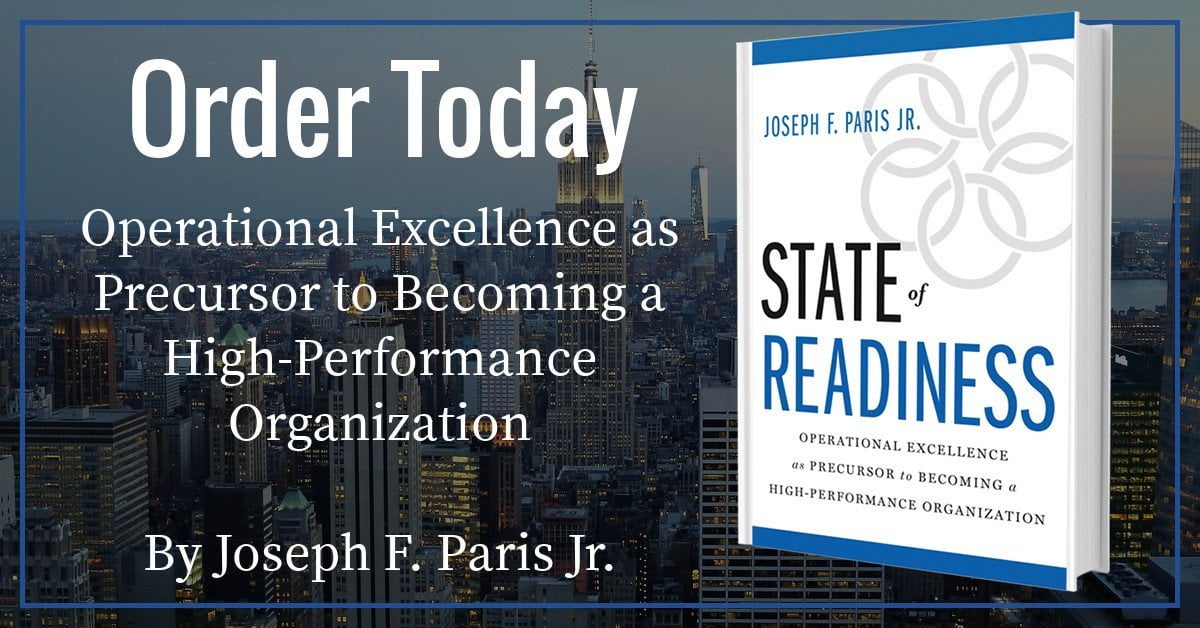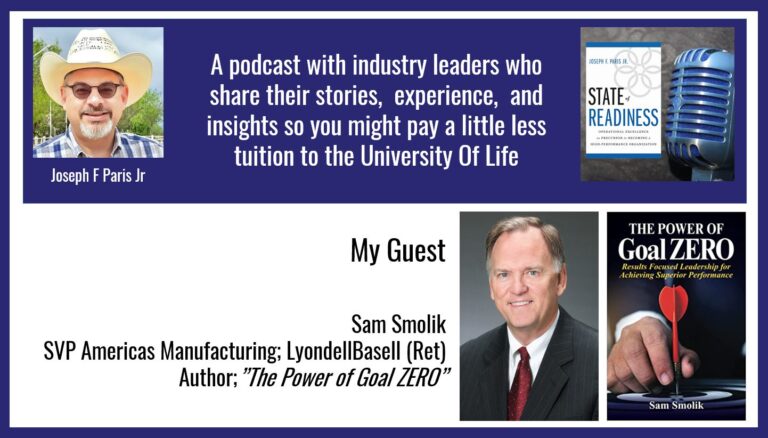Briefing; A “State of Readiness”
It’s taken a long time—but the time has finally come. The release of my book, “State of Readiness”, has arrived.
My project officially started almost two and a half years ago. That was the day I formally sat down and decided to write a book. But it’s beginning can be traced to an article I wrote in 2012 entitled, “The Operational Excellence Manifesto”. It was one of the more significant articles I had written and was the result of a considerable amount of listening, learning, and experiencing.
It was not an easy project. I learned and discovered as much (if not more) while writing it as I did leading to by deciding to write it. And my substantive editor took me to task. When I hired him he told me that he understood that I wanted to get a message out there, but it was his job to make sure people wanted to read it. I am pleased with the final results.
And, more importantly, leaders of companies—and across industries and geographies—concur (you can read some of their thoughts at the books website www.state-of-readiness.com).
Why Being in a State of Readiness is Important
We read much today about a company needing to be the “innovation company” or the “disruptive company”. But companies face real peril if they are not in a “state of readiness”— having the capacity and capability horizontally across the business smokestacks of the enterprise or vertically through the corporate hierarchy—to realize the innovation and cope with the disruption.
Adding to the challenge, the ways and means of businesses operating around the world have been increasingly optimized over time, even while supply chains and finance have become more complex and stretch further around the globe—in pace with advances in transportation and technology. Today, we think nothing of going to the grocery store and purchasing a pint of fresh strawberries, regardless of the season. But what has really changed in business—and even in our own lives—is the incremental, relentless compression of time.
More specifically, that we and our companies need to accomplish more in order to remain competitive and relevant—even viable—in a continually decreasing amount of time. How does a company accomplish more in less time and not spin out of control? The challenge is increasing efficiency while also increasing effectiveness. We have to manage multiple (often competing) priorities.
We need to recognize opportunities and threats to our strategies, and we must formulate and deploy effective countermeasures to maintain control over our own narrative. We need to make sound decisions quickly — often from imperfect data. And we need to do all of this in real time.
This is the nature of operational excellence and the essence of its importance: The organizations that pursue operational excellence will achieve a state of readiness to quickly identify and decisively engage opportunities and threats and more rapidly develop and execute their strategies. In doing so, they will become a high-performance organization.
I have had the opportunity to work with countless companies and people within those companies all around the world. Even with two sets of additional pages, my passport is almost full, with a full four years before it expires. Most of my experiences have been very positive. I consider the relatively few experiences that were not positive as paying tuition to the University of Life.

Who might be interested in, and benefit from, reading this book?
You are an executive in a company—perhaps even in the C-suite—who needs to accelerate the realization of your vision for the company and recognize you need the help of others to accomplish this. And you could do this, if only . . .
Or . . .
You are in operations or part of the continuous improvement efforts within your organization and feel you are not getting the proper attention and support from the executive leadership. And you could do so much more, if only . . .
If only what?
The answers to that are why I wrote this book—to share my observations and experiences, developed over more than thirty years, of how things are, how they could be, and what it takes to get from where you are to where you want to be. We’ll discuss things to avoid, things to embrace, and how to see the signals within your organization that foreshadow its future state. I want to share what I have learned with you so you might not have to pay as much tuition to the University of Life as I have.
I am not going to say it’s easy. There is no button to push or pill you can swallow that will make it easier or faster. It’s damn hard work, and it’s going to take time, effort, investment, gumption, and perseverance. And if you think it can be otherwise, you need to forgo this book and walk away—because it’s definitely not for you.
The Operational Excellence Manifesto (Redux)
Operational excellence is a term you’ve probably heard a thousand times. There are centers for excellence and even prizes and certifications awarded for various forms and manifestations of it. But what does it mean? Let’s start by differentiating operations from operational.
Operations refers to processes, whereas operational deals with systems—even entire enterprises. Accordingly, there must be a difference between excellence in operations, or process excellence, and operational excellence. Simply put, excellence in operations is efficiency, doing things right, but operational excellence is effectiveness, doing the right things.
For instance, when the United States Navy determines that a carrier group is operational, it means the carrier group, as an entity, is in a state of readiness to fulfill its intended purpose. And all of the nearly infinite number of individual processes that determine how the operations of the group are conducted are optimized and configured into systems that govern how the carrier group performs. When that state of readiness is achieved, the carrier group acts as a high-performance organization.
Over the past several years, I have seen a great many organizations (companies and in academia) and professionals (practitioners and consultants) attempt to hijack the term operational excellence in an effort to rebrand the disciplines of Lean Six Sigma or continuous improvement, which have become rather stale. Admittedly, some programs do try to build a differentiator by sprinkling some soft skills, such as leadership or culture change, into their program. But this is merely window dressing and not what operational excellence is truly all about.
So is operational excellence something new? Hardly… But it is largely undefined except through the telling of stories and sharing examples of what it looks like.
For example: In the early days of the Great Depression, one of the most ambitious builds in modern history started in Midtown Manhattan—the Empire State Building. At the time, and for some time afterward, it was the tallest building in the world. Excavation of the site started on January 22, 1930, and the ribbon-cutting ceremony took place on May 1, 1931. From start to finish, it took only one year, three months, and nine days—464 days in all to build the 2,248,355 square feet of floor space.
Even more impressive is that all of this was accomplished with 1930s technology and infrastructure, when there was little in the way of automation and a lot of manual labor. There were no highways, only waterways and steam rail. Yet the materials came from Bethlehem and Pittsburgh (one hundred and four hundred miles away respectively), and all the limestone block for the edifice came from Indiana (eight hundred miles away).
When I think about the story of the Empire State Building—all of the companies and workers involved in the project, the supply chain and the coordination required, the logistics necessary, the clarity of purpose held by all those involved—I think about operational excellence.
So what is the definition of operational excellence? I offer one I developed for your consideration:
“Operational Excellence is a state of readiness attained as the efforts throughout the enterprise reach a state of alignment for pursuing its strategies—where the corporate culture is committed to the continuous and deliberate improvement of company performance and the circumstances of those who work there—and is a precursor to becoming a high-performance organization.”
When a company reaches a state of readiness, it attains a situational awareness and command of its capabilities—the ability to see and anticipate opportunities and threats. Along with it comes the ability to react in a meaningful and expeditious manner to any such challenges that may present themselves—keeping in mind this awareness will never be perfect and will need to be perpetually refined.
As Mike Tyson famously said, “Everyone has a plan, until they get punched in the mouth.” That is to say, even though you are talented, trained, professional, and on the offensive pursuing your plan, the business that is better prepared to identify and engage an unforeseen challenge more quickly than its competition has a strategic and tactical advantage.
The efforts throughout the enterprise—from the vendor’s vendor to the customer’s customer, every calorie expended and every bit of treasure invested, from inception through execution and even after action, all activities from all resources and assets in any capacity—must be dedicated to these endeavors.
The business needs to practice transparency and communicate its ambitions and vision of the future in a clear and concise manner so that all of this energy, efforts, and available assets reach a state of alignment—a unity of purpose and action throughout the enterprise—for pursuing its strategies.
There should demonstrably exist—through its effective leadership, stewardship, mentorship, and followership—an ethos throughout the enterprise where the corporate culture is committed and everyone is unreservedly devoted to the effort.
When the highest level of alignment and commitment is achieved, the enterprise is prepared for action and for the continuous—meaning never-ending—engagements it needs to perform to become and remain best in class. But the enterprise is not only continuously moving, it is also moving in an intentional, calculated, engineered, and deliberate manner with not only a sense of purpose but purpose itself. Operational excellence can only be achieved by design and implemented in an engineered manner—not by accident or coincidence.
The improvement of company performance simply means to improve profit in a sustainable manner—the bottom line, EBITDA (Earnings Before Interest, Taxes, Depreciation, and Amortization), shareholder value, and whatever metric you might use to measure performance. There are many ways to facilitate increased profits, but make no mistake, businesses exist to make profits, and their improvement efforts must yield greater profits. And not just by engaging in the pursuit of short-term opportunities but also by keeping an eye on the long term, so the viability of the enterprise is ensured for the ages.
The efforts to improve company performance should ensure the company is always innovative and competitively positioned in its value proposition to its present and future customers to drive both short- and long-term value. These efforts include the following (but by no means should this list be considered exhaustive):
- Being the innovation company—the company that creates demand and marketplaces and not a company that just satisfies a preexisting need
- Aligning the company’s offerings to the desires of the marketplace and ensuring the messaging and sales efforts are effective
- Making sure the finance and equity structure are optimal for supporting the strategies of the company
- Validating the efficiency and effectiveness of the supply chain
- Considering all other influences, including those involving operations, such as Lean Six Sigma3 (LSS), the Theory of Constraints (ToC), Total Quality Management (TQM), Enterprise Resource Planning (ERP), and the entire alphabet soup of management methodologies—yes, even flow
In addition to improvements in company performance, the circumstances of those who work there, who are instrumental in making the company successful, must be equally considered. I don’t necessarily mean pay or compensation, because it’s been my experience that what is important varies with each individual.
Most people will not leave a company over a 5 or 10 percent increase in pay, but they will leave if they feel disenchanted, disrespected, detached, undervalued, or have no potential for personal or professional growth. They want a sense of pride in ownership. They want their lives to be more joyous, and they want to look at their job as a means to that joy. Company leaders who understand this will reap great rewards, both professionally and personally.
It is a colossal mistake for companies to believe they can improve company performance just by heaping more and more on the backs of their employees. It’s unsustainable, and a breaking point will eventually be reached. You need to set the company’s pace for a marathon, not a sprint, and there needs to be enough energy in reserve for a kick when it is needed.
All of this is a precursor to becoming a high-performance organization, which is the ultimate goal. Your company cannot become a high-performance organization without alignment, commitment, and effort—a lot of effort—or without improvements in performance and in the lives of the people who work there, or with a culture that is not committed to achieving a state of readiness. Your company cannot become a high-performance organization without operational excellence.
Every new company starts small and possess an entrepreneurial spirit where vision, ambition, and innovation intersect with risk and reward. It is in these early times when the employees are few and relationships are close. It is a time when debate is robust and decisions are made quickly, driven more by gut instinct than detailed analysis.
The young companies that are destined for success will be high-performance organizations. They will have the capacity and capability to grow from their nascent state through their present state on the way to their future state. Navigating this course and accomplishing these objectives requires the total alignment and commitment of its energies in the pursuit of the company’s vision if the company is to be successful.
At the very beginning of the company’s history this is simple because all of the decision-makers are in the same office, perhaps even a garage or a Starbucks. If there is a need for a brainstorming session or if a decision has to be made, all that everyone in the company needs to do is turn their chairs around and start collaborating. The team has been built and it is a tight team. Any laggards or those who otherwise don’t fit move out and move on very quickly. And it is in these early moments in the company’s history that the company’s culture is established, adopting the values and traditions of its founders as the basis for its own.
But as the company grows, the resources and supply chains get stretched further afield. The tightness of the team that existed at the founding of the company loosens as the company expands and with the addition of so many unfamiliar faces. There is a corresponding loss of the intimacy that existed in the early years of the company, and coinciding with this loss of intimacy is a reduction in trust.
Not that there is suspicion of nefarious intent, but a lack of trust that is the natural result of not having worked closely together for an extended period of time under the extreme stress that exists when launching a business—the camaraderie and bonds that are created by being Brothers in Arms. The need for team building becomes increasingly acute.
Over time and assuming the company survives its launch phase, the successful company charts an expected evolutionary course: progressing from entrepreneurial and innovative, through mature and stable, to institutional and predictable. And the energy in the company follows a similar path converting from highly kinetic into momentum as the use of speed and agility converts to that of brute force.
The challenge is this: How does a company, which must be a high-performance organization at its beginning when it’s at its most vulnerable, balance the need for protocols and controls as it grows with its need to remain innovative at high-velocity?
Like a rowboat that can quickly spin in circles versus an ocean-going vessel that requires more time and space to maneuver, as a company grows, its ability to remain nimble similarly erodes. Escaping this erosion is not possible, but limiting it is.
For your company to have a competitive advantage, it needs to regain the ability to quickly evaluate a situation and to formulate and deploy a decisive response using all of the appropriate abilities from across the business smokestacks. Obviously, the company needs to cut the waste and friction in the supply chain and in the production and delivery of its goods and services. But it is also imperative that the company constantly strive to shed the burden of bureaucracy and protocols. Hire, build, and retain the best people and give them the opportunity to impress.
As former Apple CEO Steve Jobs said; “It doesn’t make sense to hire smart people and tell them what to do; we hire smart people so they can tell us what to do.”
Becoming a high-performance organization is the ultimate goal—a business that is best in its class and is more innovative and successful than its competitors in areas such as strategy development and execution. It should be an efficient and effective organization with clear roles and accountability, delivering superior customer service and maintaining the best vendor relationships, utilizing and maintaining its assets so they reliably produce more, and consistently and sustainably generating more profits.
After all, the competitive advantage of the 21st Century company will not be the one who has only achieved excellence in their operations. The competitive advantage will belong to the company that takes excellence beyond processes to systems and organizations—the one that is able to see the opportunities and threats further beyond the horizon than their competitors and have the capacity and capability to accelerate their decision-making process so as to be able to devise and deploy strategies more quickly, more reliably, more decisively, and more successfully.
In the end, it’s about improving the way people in an organization think and act. If we design and implement a program that enables a tighter alignment of the efforts of the various individual business functions with the top-level strategies of the company and facilitates and accelerates the achievement of those strategies (but not so rigidly that it stifles innovation and agility), the company will obtain the ability to quickly and decisively react to opportunities and threats as they are identified and even learn to anticipate and seek them out. This is operational excellence.
This definition, applied throughout an organization and its value chain—from its vendor’s vendor to its customer’s customer—is the manifesto of operational excellence and, if pursued with vigilance, will result in your company becoming a high-performance organization.
Pursuing operational excellence is a never-ending race without a finish line.
About the author

Paris is the Founder and Chairman of the XONITEK Group of Companies; an international management consultancy firm specializing in all disciplines related to Operational Excellence, the continuous and deliberate improvement of company performance AND the circumstances of those who work there – to pursue “Operational Excellence by Design” and not by coincidence.
He is also the Founder of the Operational Excellence Society, with hundreds of members and several Chapters located around the world, as well as the Owner of the Operational Excellence Group on Linked-In, with over 40,000 members.
Connect with him on LinkedIn.







